This was published 2 years ago
Baku and surrounds, Azerbaijan, travel guide: Uncovering the mysteries of this little-known country
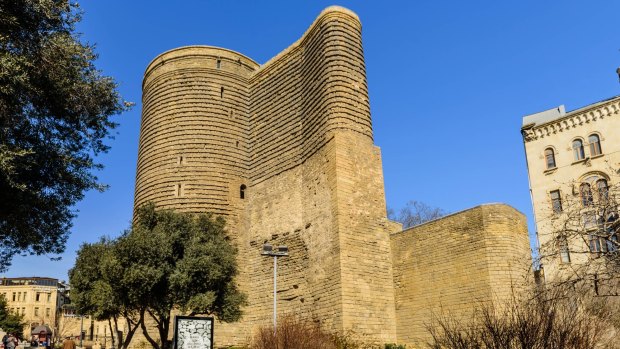
The mysterious Maiden Tower in Baku, Azerbaijan. Credit: iStock
"We don't know the tower's age, purpose or historical context," says my guide, Ramin Bagirov, as we step inside Baku's Maiden Tower, a stone citadel inside the city's Old Town. "It's one of Azerbaijan's greatest mysteries."
Shaped like a paisley leaf, all plump sides and curly tail, the 30-metre tower stands on a rocky outcrop overlooking the Caspian Sea. While archaeologists agree it was built somewhere between the 6th and 12th centuries, the debate continues as to whether it was used as a fortress, temple or astronomical observatory.
Outside in the sunshine, it's the tower's teardrop shape that intrigues. Since arriving in Baku I've been charmed and delighted by the never-ending parade of paisley. Jaunty as peacocks; indigo rugs laced with copper threads, purple headscarves swirled with amber, fuchsia shawls mottled with the turquoise of Azerbaijani tiles.
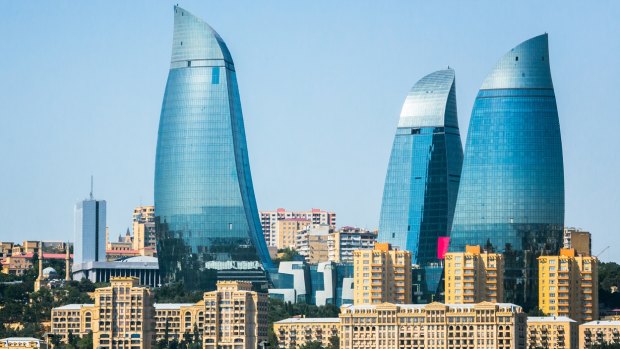
Baku's most ambitious flame motif is the Flame Towers, a trio of glass-sheathed skyscrapers that light up the city each night. Credit: iStock
From its ancient Indo-Persian origins, the paisley pattern – interpreted as a palm shoot, teardrop, mango or flickering flame - travelled the caravan routes of the Silk Road from East to West, a symbol of life and eternity. In recent decades paisley has been a firm favourite of the flamboyant and the fashionable, from Bowie to the Beatles to the '70s hippies. But nowhere has the paisley motif – or buta to the Azeris – been adopted so exuberantly as in Azerbaijan.
"The Maiden Temple may have started as a Zoroastrian fire temple," says Bagirov. "Its buta shape suggests the symbol for fire."
Known as the Land of Fire – thanks to the fields of flames that burst spontaneously from underground gas deposits – Baku's most ambitious flame motif is the Flame Towers, a trio of glass-sheathed skyscrapers that light up the city each night. There's even a paisley-shaped petrol station.
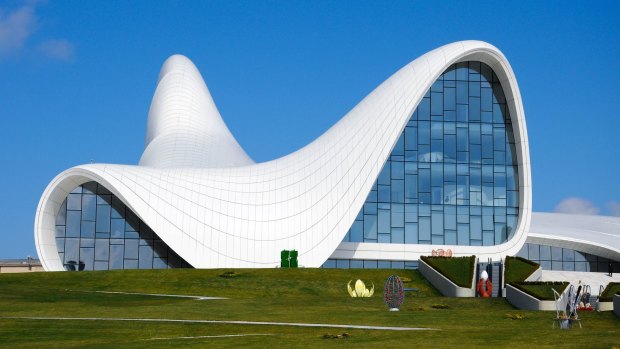
The rolling, soft-serve curves of Zaha Hadid's Heydar Aliyev Centre.Credit: iStock
Yes, Baku is hot right now. Proudly independent since the collapse of the Soviet Union in 1991, prosperous due to an influx of oil wealth, and confident thanks to an ambitious - if authoritarian – government, the capital is booming.
"We've been dubbed the Dubai of the Caucasus," says Bagirov.
But in three short days I've seen that Baku's treasures run deeper than this. I've spent hours inside the rolling, soft-serve curves of Zaha Hadid's Heydar Aliyev Centre, enjoying the artworks and photographic exhibitions. I'd discovered a contemporary art space inside a former ship maintenance warehouse and a project space for emerging Azeri artists tucked inside the Old City.
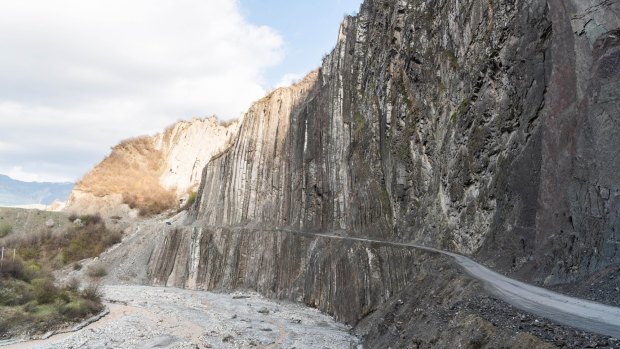
To get to Lahic village we must tackle the southern slopes of the Greater Caucasus mountains.Credit: iStock
On the streets Soviet-era buildings sit side-by-side with trendy wine bars like Kefli, where the staff are knowledgeable and every bottle on the extensive wine list comes from Azerbaijan. On the waterfront the Azerbaijan Carpet Museum, created in the shape of a rolled up rug, is an exotic world of magical carpets, colour and design.
It's day four of my 10-day "Highlights of Azerbaijan and Georgia" tour with Intrepid Travel when we leave the city behind for Lahic in the Greater Caucasus Mountains. We are a small group of 12 from Australia, New Zealand, Great Britain, Canada and the US, united in a desire to visit places far off the well-worn tourist path.
We take the freeway that leads south to Iran, passing chalky oil fields, where pumping jacks known as "nodding donkeys" mark time like metronomes, and detour to a field of mud volcanoes, so bizarre it has us rubbing our eyes and wondering what planet we are on.
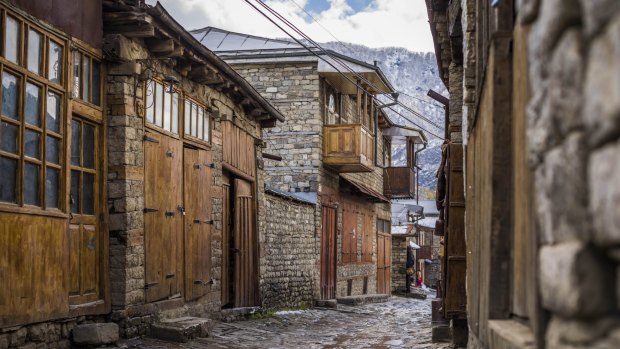
The cobblestone streets of Lahic.Credit: iStock
Azerbaijan has almost 400 mud volcanoes," explains Bagirov. "More than any other country on earth." We trudge up cracked and charred domes, our boots breaking the brittle surface as we peer inside bubbling vents. From up high the view is astounding; a humped, reptilian landscape, wheezing and breathing like a pack of sleeping dragons. "It's very rare, but yes, they have been known to explode," says Bagirov, as if reading our minds.
We turn north-west, stopping for lunch with a family in the town of Shamakhi on the foothills of the Greater Caucasus Mountains. A simple snack of chewy flatbread filled with spinach and coriander, hot from the griddle and served with salty, home-churned butter has never tasted so good.
Despite the wealth of Baku, not a lot trickles down to these remote villages. Grateful for the extra manats our visit has brought, the family matriarch Ayna slips her hand into mine as we walk back to our van, the warmth of her smile and spring in her step far outweighing anything I may have given.
Intrepid Travel, the small group travel operator known for its dedication to responsible tourism, is committed to making a tangible difference – by investing in local communities, supporting grass roots projects and creating meaningful work through The Intrepid Foundation.
To get to Lahic village we must tackle the southern slopes of the Greater Caucasus mountains, overtaking spluttering Ladas, dodging stray goats and passing stalls selling colourful fruit wheels, which are strung between trees like Christmas garlands.
Halfway up the pass we swap vehicles, trading our modern coach for a local minivan and driver, both smoking and belching and making equally suspect noises. The Road to Lahic is touted as one of the most dangerous drives in the world, its tight switchbacks and dizzying drops turning even the most stoic of travellers a Kermit-shade of green. It is also one of the most beautiful; where jagged peaks climb halfway to the sky and the silver braids of the Girdimanchai River twist far below.
Lahic arrives in a rush of cobblestone and copper, the tink- tink of metal being hammered echoing across the 2000-year-old mountain village. Once an important stop on the Silk Road route, the inhabitants, who speak a dialect of the Persian Tat language, are renowned for their quality craftsmanship.
Like travellers of old we spend the night in a family guesthouse, dining on slow roasted chicken and dolma wrapped in leaves collected from the forest. In the morning we hike across meadows flush with wildflowers and in the afternoon we shop for small copper teapots, their sides etched with posies of paisley buds.
Sheki is another Silk Road gem; streets lines with mulberry trees, 300-year-old caravanserais, where traders' camels once rested, and a former summer palace of the Sheki khans, its private chambers hand-painted with frescoes of plants and paisleys.
After the collapse of the Soviet Union in 1991, and the resulting closure of more than 100 silk factories, Sheki paisleys are on the comeback trail. On a dusty backstreet in the historic heart of Sheki we meet Aslan, a silk master who is reviving the ancient art of hand-dyed silk scarves known as Kelaghayi.
Aslan leads us from the brick and stone dye room, with its rows of plum-tinted tubs, to the kaleidoscopic printing room. With a fluid motion, perfected and handed down through generations, we watch as the lone printer dips the paisley-shaped wooden block into a vat of dye, before pressing it against the delicate fabric. With each dip and press she paints a voluptuous flower garden, layer upon layer of petals, buds and leaves, the ever-lasting symbol of life, fire and eternity.
In the days ahead the paisley path will lead me to Georgia, and the great Silk Road city of Tbilisi, but for now I'm happy to chat with Aslan, about his plans to take his scarves to Paris, and the pride he felt in 2014, when the art of the traditional Kelaghayi was inscribed on the UNESCO Representative List of the Intangible Cultural Heritage of Humanity.
How a blind, flightless moth could spin a thread so coveted it would spawn a 7000-kilometre caravan route is perhaps the greatest mystery of all.
Five other Azerbaijan excursions
YANAR DAG (Burning Mountain)
A wall of fire that burns continuously on a hillside on the Absheron Peninsula, 15 kilometres from Baku. See www.yanardag.az
GOBUSTAN NATIONAL PARK
A collection of more than 6, 000 rock engravings – ships, wild horses, ceremonial dancing - spanning 40, 000 years of rock art. See www.unesco.org
NIDJ VILLAGE
Home to the Udi people, direct descendants of the ancient Caucasian Albanians. Stroll through the bazaar, enjoy a quiet tea or visit the Albanian Church.
JUMA MOSQUE, SHAMAKI
Built in the 8th century (although damaged and reconstructed several times) this is one of the oldest and most interesting mosques in Azerbaijan.
KIS VILLAGE
Located just five-kilometres north of Sheki, Kis village is famous for its 12th-century Albanian church. Arrive by Lada for the full experience.
DETAILS
MORE
TOUR
Intrepid Travel's 10-day Highlights of Azerbaijan and Georgia, starting in Baku, costs from $3110 a person, twin share and will resume in April 2022. See intrepidtravel.com
FLY
Qatar Airways flies from Sydney and Melbourne to Baku, Azerbaijan via Dohar. See qatarairways.com
ENTRY
At the time of publication, Australian citizens and residence permit holders can enter and exit Azerbaijan by air only. Land borders remain closed. There are currently no restrictions on travel within Azerbaijan. All travellers must provide evidence of a negative PCR COVID-19 test and a vaccination certificate. See smartraveller.gov.au/destinations/europe/azerbaijan
Kerry van der Jagt was a guest of Intrepid Travel.
Sign up for the Traveller Deals newsletter
Get exclusive travel deals delivered straight to your inbox. Sign up now.